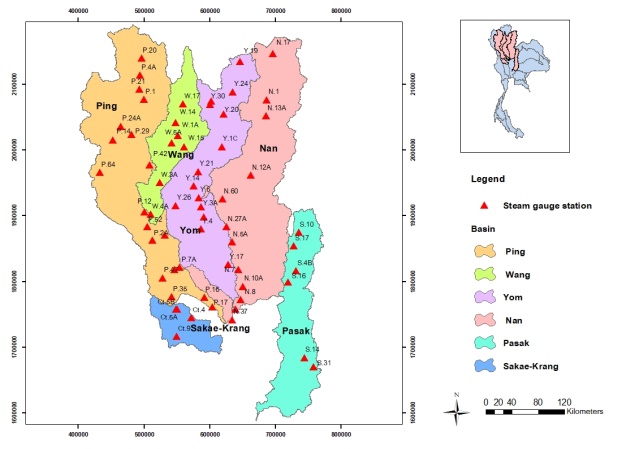การเปรียบเทียบอนุกรมสูงสุดประจำปีและอนุกรมช่วงเวลาย่อยสำหรับการวิเคราะห์ แจกแจงความถี่ของปริมาณน้ำหลาก | Comparison of Annual Maximum Series and Partial Maximum Series for Flood Frequency Analysis
Main Article Content
Abstract
This research is a comparative study of peak flood analysis at different annual times from
the Annual Maximum Series (AMS) and Partial Maximum Series (PDS) data, in the 6 main river basins of Thailand namely Ping River Basin, Wang River Basin, Yom River Basin, Nan River Basin, Pasak River Basin, and Sakaekrang River Basin, by using Gumbel distribution to analyze the maximum amount of recurrent flood of maximum daily flood data from AMS and PDS data by considering the return period from 2 years to 10,000 years, and then to compare the differences between the results of the analysis of the maximum volume of floods to different return period, each station from the data used in the analysis of all 62 stations and each of the six basins. The study indicated that, for each examined station, the maximum number of recurring floods in the return period from the AMS data is greater than the maximum number of return period from PDS data, representing 95% of the number of stations studied. When considering each basin, it was found that the basin that had the difference of the highest amount of flood recurrence during the return period of AMS and PDS data is the Ping River Basin, with a range of the highest amount of flood at different return period, 0.2% to 89.3%. And the basin that has the difference of the least amount of flood recurrence from AMS and PDS data is the Sakaekrang River Basin, with a range of the highest amount of flood at different return period, 29.6% to 56.2%. Moreover, when analyzing the maximum number of recurring floods all year round per Unit Peak Discharge of the stations measuring the amount of runoff water studied in each basin, it was found that the trend of the difference between the maximum amount of flood in the return period from AMS and PDS data has decreased with higher return period.
บทคัดย่อ
งานวิจัยนี้เป็นการศึกษาการเปรียบเทียบการวิเคราะห์น้ำหลากสูงสุดที่รอบปีการเกิดต่างๆ จากข้อมูลอนุกรมสูงสุดประจำปี (Annual Maximum Series, AMS) และอนุกรมช่วงเวลาย่อย (Partial Maximum Series, PDS) ในพื้นที่ 6 ลุ่มน้ำหลักของประเทศไทย ได้แก่ ลุ่มน้ำปิง ลุ่มน้ำวัง ลุ่มน้ำยม ลุ่มน้ำน่าน ลุ่มน้ำป่าสัก และลุ่มน้ำสะแกกรัง โดยใช้ทฤษฎีการแจกแจงความถี่ด้วยวิธีกัมเบล (Gumbel Distribution) เพื่อวิเคราะห์หาปริมาณน้ำหลากสูงสุดที่รอบปีการเกิดซ้ำของข้อมูลปริมาณน้ำท่าสูงสุดรายวันจากข้อมูล AMS และจากข้อมูล PDS โดยพิจารณาตั้งแต่รอบปีการเกิดซ้ำที่ 2 ปี ถึง 10,000 ปี จากนั้นจึงเปรียบเทียบความแตกต่างของผลการวิเคราะห์ปริมาณน้ำหลากสูงสุดที่รอบปีการเกิดซ้ำต่างๆ รายสถานีจากข้อมูลที่ใช้ในการวิเคราะห์ทั้ง 62 สถานี และรายลุ่มน้ำทั้ง 6 ลุ่มน้ำ ผลการศึกษาพบว่า เมื่อพิจารณาเป็นรายสถานี ปริมาณน้ำหลากสูงสุดที่รอบปีการเกิดซ้ำต่างๆ จากข้อมูล AMS มีค่ามากกว่าปริมาณน้ำหลากสูงสุดที่รอบปีการเกิดซ้ำต่างๆ จากข้อมูล PDS คิดเป็นร้อยละ 95 ของจำนวนสถานีที่ทำการศึกษา และเมื่อพิจารณาเป็นรายลุ่มน้ำ พบว่า ลุ่มน้ำที่มีความแตกต่างของปริมาณน้ำหลากสูงสุดที่รอบปีการเกิดซ้ำจากข้อมูล AMS และ PDS มากที่สุด คือ ลุ่มน้ำปิง โดยมีช่วงพิสัยของปริมาณน้ำหลากสูงสุดที่รอบปีการเกิดซ้ำต่าง ๆ ที่แตกต่างกันร้อยละ 0.2 ถึงร้อยละ 89.3 และลุ่มน้ำที่มีความแตกต่างของปริมาณน้ำหลากสูงสุดที่รอบปีการเกิดซ้ำจากข้อมูล AMS และ PDS น้อยที่สุด คือ ลุ่มน้ำสะแกกรัง โดยมีช่วงพิสัยของปริมาณน้ำหลากสูงสุดที่รอบปีการเกิดซ้ำต่าง ๆ ที่แตกต่างกันร้อยละ 29.6 ถึงร้อยละ 56.2 นอกจากนี้เมื่อวิเคราะห์ค่าปริมาณน้ำหลากสูงสุดที่รอบปีการเกิดซ้ำต่างๆ ต่อพื้นที่รับน้ำฝน (Unit Peak Discharge) ของสถานีวัดน้ำท่าที่ศึกษาในแต่ละลุ่มน้ำ พบว่าแนวโน้มของความแตกต่างระหว่างปริมาณน้ำหลากสูงสุดที่รอบปีการเกิดซ้ำจากข้อมูล AMS และ PDS มีค่าลดลงที่รอบปีการเกิดซ้ำที่สูงขึ้น
Downloads
Article Details
References
ชูเกียรติ ทรัพย์ไพศาล และไตรรัตน์ ศรีวัฒนา. (2529). การป้องกันน้ำท่วมและการะบายน้ำของมหานคร. งานสื่อการศึกษา (น. 418). กรุงเทพฯ: สำนักส่งเสริมและฝึกอบรม มหาวิทยาลัยเกษตรศาสตร์บางเขน.
ไชยาพงษ์ เทพประสิทธิ์. (2560). การระบายน้ำและการป้องกันน้ำท่วม (เอกสารประกอบการสอน). ภาควิชาวิศวกรรมชลประทาน คณะวิศวกรรมศาสตร์มหาวิทยาลัยเกษตรศาสตร์ วิทยาเขตกําแพงแสน.
วรภัต ธรรมประทีป. (2546). การเสริมสร้างฐานความรู้เกี่ยวกับการวิเคราะห์น้ำหลาก กรณีศึกษาลุ่มน้ำปิง วัง ยม และน่าน. วิทยานิพนธ์ปริญญามหาบัณฑิต, จุฬาลงกรณ์มหาวิทยาลัย.
วิษุวัฒก์ แต้สมบัติ. (2555). อุทกวิทยาทางวิศวกรรม (เอกสารประกอบการสอน). ภาควิชาวิศวกรรมชลประทาน คณะวิศวกรรมศาสตร์ มหาวิทยาลัยเกษตรศาสตร์ วิทยาเขตกำแพงแสน.
Madsen, H., Rasmussen, P. F., & Rosbjerg, D. (1997). Comparison of annual maximum series and partial duration series methods for modeling extreme hydrologic events: 1. At‐site modeling. Water resources research, 33(4), 747-757.
Bhagat, N. (2017). Flood frequency analysis using Gumbel's distribution method: a case study of Lower Mahi Basin, India. Journal of Water Resources and Ocean Science, 6(4), 51-54.
Solomon, O., & Prince, O. (2013). Flood frequency analysis of Osse river using Gumbel’s distribution. Civil and Environmental Research, 3(10), 55-59.
Sabur, M.A. (1982). Regional flood frequency analysis of Thailand. (Master’s thesis), Asian Institute of Technology, Bangkok.

